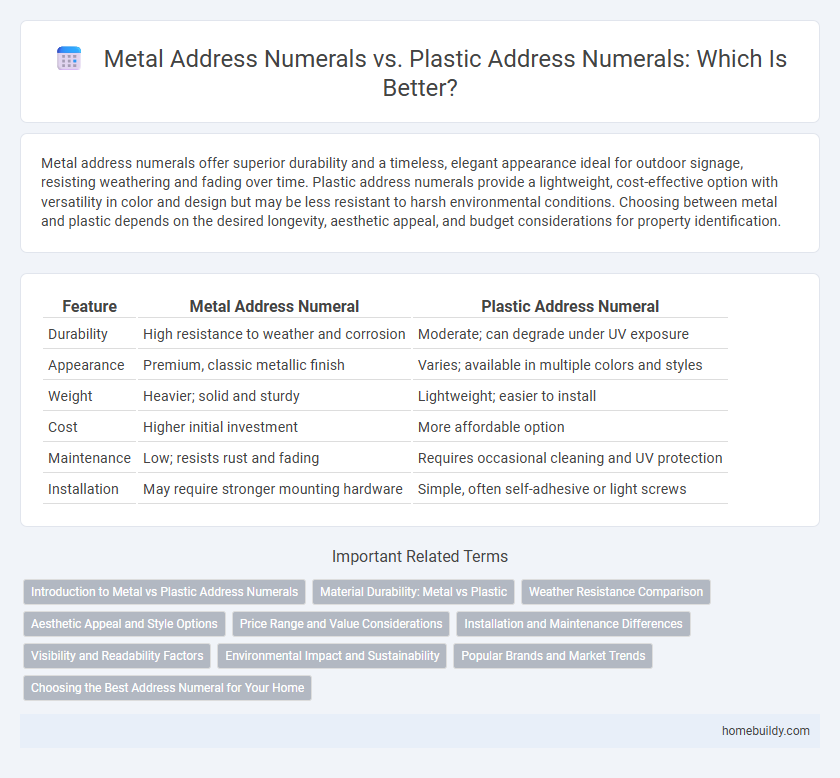Metal address numerals offer superior durability and a timeless, elegant appearance ideal for outdoor signage, resisting weathering and fading over time. Plastic address numerals provide a lightweight, cost-effective option with versatility in color and design but may be less resistant to harsh environmental conditions. Choosing between metal and plastic depends on the desired longevity, aesthetic appeal, and budget considerations for property identification.
Table of Comparison
| Feature | Metal Address Numeral | Plastic Address Numeral |
|---|---|---|
| Durability | High resistance to weather and corrosion | Moderate; can degrade under UV exposure |
| Appearance | Premium, classic metallic finish | Varies; available in multiple colors and styles |
| Weight | Heavier; solid and sturdy | Lightweight; easier to install |
| Cost | Higher initial investment | More affordable option |
| Maintenance | Low; resists rust and fading | Requires occasional cleaning and UV protection |
| Installation | May require stronger mounting hardware | Simple, often self-adhesive or light screws |
Introduction to Metal vs Plastic Address Numerals
Metal address numerals offer superior durability and weather resistance compared to plastic address numerals, making them ideal for outdoor use in various climates. Metal numerals often feature a more premium appearance, with finishes such as brushed aluminum, brass, or stainless steel that resist fading and corrosion. Plastic address numerals, while more affordable and available in a wider range of colors, may degrade faster under UV exposure and harsh weather conditions.
Material Durability: Metal vs Plastic
Metal address numerals offer superior durability compared to plastic counterparts, resisting weathering, UV exposure, and physical impact more effectively. High-quality metals such as stainless steel or brass maintain their structural integrity and appearance for decades, whereas plastic numerals may degrade, fade, or crack over time. The long-lasting nature of metal materials makes them a preferred choice for exterior address displays requiring minimal maintenance.
Weather Resistance Comparison
Metal address numerals exhibit superior weather resistance compared to plastic address numerals due to their durability and ability to withstand extreme temperatures, UV radiation, and heavy precipitation without warping or fading. High-quality metals such as stainless steel, brass, and aluminum offer corrosion resistance, ensuring longevity in harsh outdoor environments. Conversely, plastic numerals may degrade over time with exposure to sunlight and moisture, leading to brittleness and discoloration.
Aesthetic Appeal and Style Options
Metal address numerals offer a sleek, modern aesthetic with a polished or brushed finish that enhances curb appeal and complements contemporary home designs. Plastic address numerals provide a versatile range of colors and styles, allowing homeowners to customize their look with bold or subtle hues that suit various architectural themes. Choosing between metal and plastic ultimately depends on desired durability and design preferences, with metal providing a premium, timeless look and plastic offering cost-effective, diverse style options.
Price Range and Value Considerations
Metal address numerals typically range from $15 to $50 per set, offering enhanced durability and a premium aesthetic that justifies the higher cost. Plastic address numerals are more budget-friendly, generally priced between $5 and $20, but may lack longevity and resist weathering less effectively. Choosing between metal and plastic involves balancing upfront cost with long-term value, as metal numerals often provide better return on investment due to their resilience and classic appearance.
Installation and Maintenance Differences
Metal address numerals require specialized tools such as drills and anchors for installation on brick or stone surfaces, offering a durable and secure mount. Plastic address numerals often use adhesive backing or simple screws, enabling quick installation on a variety of surfaces without heavy tools. Maintenance of metal numerals involves periodic cleaning and rust prevention, whereas plastic numerals demand minimal upkeep but may degrade faster under prolonged UV exposure.
Visibility and Readability Factors
Metal address numerals offer superior visibility due to their reflective surfaces and durability, which resist fading and weathering over time. Plastic address numerals may suffer from color degradation and reduced contrast, impacting readability, especially in low-light conditions. Choosing metal numerals ensures clearer, longer-lasting visibility from greater distances and varying angles, enhancing overall address identification.
Environmental Impact and Sustainability
Metal address numerals have a longer lifespan and are often recyclable, reducing environmental waste compared to plastic numerals, which can degrade faster and contribute to landfill pollution. Metals such as aluminum and stainless steel can be efficiently recycled without loss of material quality, supporting sustainable resource use. Plastic numerals typically rely on petroleum-based materials, leading to higher carbon footprints and challenges in biodegradability, making metal options a more environmentally responsible choice.
Popular Brands and Market Trends
Popular brands like Rumah and Acme dominate the metal address numeral market, known for durability and premium finishes that appeal to upscale homeowners. In contrast, plastic address numerals from brands such as Liberty and Nutone focus on affordability and ease of installation, leading to growing demand in budget-conscious markets. Market trends indicate a rising preference for sustainable materials, pushing metal numeral manufacturers to innovate with eco-friendly metals and finishes.
Choosing the Best Address Numeral for Your Home
Metal address numerals offer superior durability, weather resistance, and a classic aesthetic that enhances your home's curb appeal, making them ideal for long-term use. Plastic address numerals provide a cost-effective alternative with a wide variety of styles and colors, though they may fade or crack over time when exposed to harsh environmental conditions. Selecting the best address numeral depends on factors like budget, desired longevity, and the architectural style of your home to ensure visibility and aesthetic harmony.
Metal address numeral vs plastic address numeral Infographic

 homebuildy.com
homebuildy.com